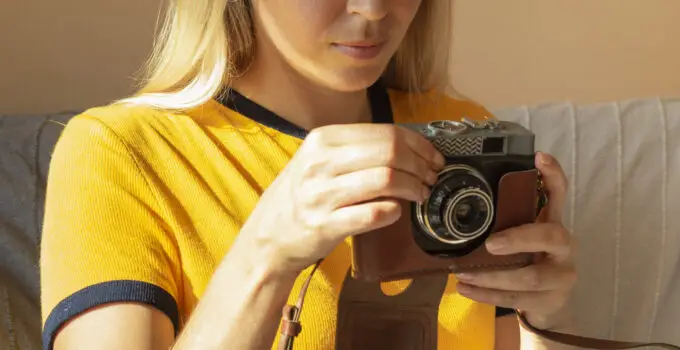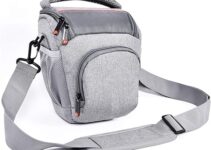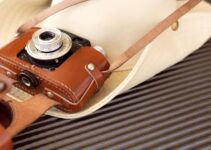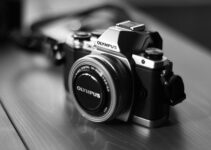Table of Contents
ToggleEver wondered how to securely attach a lanyard to your camera?
Whether you’re a professional photographer or a casual hobbyist, ensuring your camera is safely tethered is crucial for both convenience and security.
A lanyard not only makes it easier to carry your camera around but also reduces the risk of accidental drops.
To attach it correctly, you’ll need to find the appropriate attachment points on your camera, usually located on the sides or bottom.
With the right technique, you can ensure that your lanyard is both sturdy and comfortable, making your photography experience more enjoyable and worry-free.
Here 10 best camera bag designer?
Can you attach a lanyard to a camera?
Yes, you can attach a lanyard to a camera, and it’s a practical way to keep it secure and easily accessible. Most cameras have a strap or lanyard attachment points, typically small loops or rings on the sides or bottom of the camera body. To attach a lanyard, follow these steps:

- Check for Attachment Points: Look for the small rings or loops on your camera. These are usually found on the sides or near the base.
- Thread the Lanyard: Pass the lanyard’s attachment clip or strap through the camera’s attachment point. If using a clip, ensure it securely fastens.
- Adjust Length: Adjust the lanyard’s length for comfort, so it hangs at a convenient height.
- Secure: Make sure the attachment is tight and secure to prevent the camera from slipping or falling.
A lanyard helps distribute the camera’s weight evenly and reduces the risk of dropping it.
Things to know before attaching a lanyard to a camera?
Before attaching a lanyard to a camera, consider these key factors:
- Attachment Points: Ensure your camera has designated attachment points. Some models might require special adapters if they lack built-in loops or rings.
- Lanyard Compatibility: Choose a lanyard that fits the attachment points of your camera. Some lanyards come with adjustable clips or quick-release mechanisms for added convenience.
- Weight and Strength: Confirm that the lanyard can support the weight of your camera. For heavier cameras, opt for a robust lanyard made from durable materials like nylon or leather.
- Comfort: Select a lanyard with adjustable length and padding if you plan to carry the camera for extended periods. A well-padded lanyard will enhance comfort and reduce strain on your neck or shoulder.
- Security: Ensure the lanyard is securely fastened to avoid accidental drops. Double-check the attachment points and clips regularly.
How to attach a lanyard to a camera?
To attach a lanyard to a camera, follow these steps:
- Locate the Attachment Points: Find the small rings or loops on your camera where the lanyard can be attached. These are typically located on the sides or bottom of the camera body.
- Prepare the Lanyard: If your lanyard has clips or loops, ensure they are open and ready for attachment. Some lanyards come with adjustable sliders or buckles.
- Thread the Lanyard: Pass the lanyard’s clip or strap through the attachment point on the camera. For lanyards with loops, simply thread the loop through the ring.
- Secure the Attachment: If using a clip, snap it securely into place. For loops, make sure the lanyard is properly threaded and tight.
- Adjust the Length: Adjust the lanyard to a comfortable length, ensuring it hangs at a convenient height for easy access.
Double-check that everything is secure before using the camera.
How do you connect a lanyard?
Moreover, to connect a lanyard, follow these steps:
- Identify Connection Points: Locate the attachment points on the device or item you’re connecting the lanyard to. These are typically small loops or rings.
- Prepare the Lanyard: If your lanyard has clips, carabiners, or loops, make sure they are ready for attachment. Open any clips or buckles as needed.
- Attach the Lanyard: For clips or carabiners, hook them onto the attachment points and ensure they snap securely. For loops, thread the loop through the ring or attachment point and pull it tight.
- Adjust the Length: If the lanyard has adjustable features, set it to the desired length for comfort and practicality.
- Check Security: Confirm that the lanyard is firmly attached and won’t come loose. Test it by gently tugging to ensure it’s securely fastened.
Following these steps ensures the lanyard is connected safely and effectively.
5 Tips to attach a lanyard to a camera
1. Check Attachment Points
Thus, before attaching a lanyard, verify that your camera has suitable attachment points. Most cameras have designated rings or loops specifically for straps and lanyards.
These are usually located on the sides or base of the camera body. If your camera lacks these points, you might need an adapter.
Here, can a camera bag be a personal item?
Ensuring compatibility is crucial for a secure fit and to avoid any potential damage to your camera. Refer to your camera’s manual for specific instructions and attachment points to make sure you’re using the correct locations.
2. Choose the Right Lanyard
Select a lanyard that is compatible with your camera’s attachment points and suitable for its weight.
For heavier cameras, opt for a sturdy lanyard made from durable materials like nylon or leather.
Ensure the lanyard has a reliable clasp or adjustable strap to fit your needs. A lanyard that is too thin or weak might not support the weight of your camera properly, risking potential damage or drops. Consider lanyards with additional padding for comfort, especially if you carry your camera for extended periods.
3. Securely Attach the Lanyard
Well, when attaching the lanyard, make sure the connection is firm and secure.
If your lanyard has clips or carabiners, ensure they snap into place properly. For lanyards with loops, thread the loop through the camera’s attachment point and pull it tight to prevent slipping. Double-check that all connections are secure before use.
can you use camera bag as a diaper bag?
An improperly attached lanyard can lead to accidents or damage, so taking a moment to ensure everything is firmly in place will help prevent potential issues during use.
4. Adjust the Length
After attaching the lanyard, adjust its length to ensure it’s comfortable for use. Most lanyards come with adjustable sliders or buckles to customize the length. Set the length so that the camera hangs at a convenient height, making it easy to access and use.
An adjustable lanyard helps distribute the camera’s weight evenly and reduces strain on your neck or shoulder. Proper adjustment enhances comfort, making it easier to carry your camera for extended periods without discomfort.
5. Regularly Check for Wear and Tear
Well, regularly inspect the lanyard and its connections for signs of wear and tear.
Over time, the lanyard might become frayed, or the clips might loosen. Frequent checks help ensure that the lanyard remains in good condition and securely attached.
Replace any worn-out components immediately to avoid potential accidents or damage to your camera. Routine maintenance of the lanyard ensures it continues to function properly and provides the necessary support and security for your camera.
5 Steps to attach a lanyard to a camera
1. Locate the Attachment Points
Thus, start by identifying the attachment points on your camera where the lanyard will be connected. These are typically small metal rings or loops located on the sides or the bottom of the camera body.
Consult your camera’s manual if you’re unsure where these points are. If your camera lacks built-in attachment points, you might need a separate adapter. Properly locating these points ensures a secure and stable attachment for your lanyard.
2. Prepare the Lanyard
Before attaching the lanyard, prepare it by opening any clips or buckles and ensuring that it’s free of tangles. If your lanyard has adjustable features, set them to their maximum length initially.
Check the lanyard for any signs of wear or damage. For lanyards with loops, ensure that they’re intact and not frayed. Proper preparation helps facilitate a smooth and secure attachment process.
3. Attach the Lanyard
Moreoer, securely attach the lanyard to the camera by threading the clip or loop through the attachment points. For clips, ensure that they snap into place properly on the camera’s attachment rings.
For lanyards with loops, thread the loop through the ring and pull it tight to ensure a secure fit. Make sure the lanyard is firmly attached to avoid any risk of the camera falling or becoming detached.
Here, what are camera bag used for?
4. Adjust the Length
After attaching the lanyard, adjust its length to fit comfortably. Most lanyards have adjustable sliders or buckles that allow you to set the desired length.
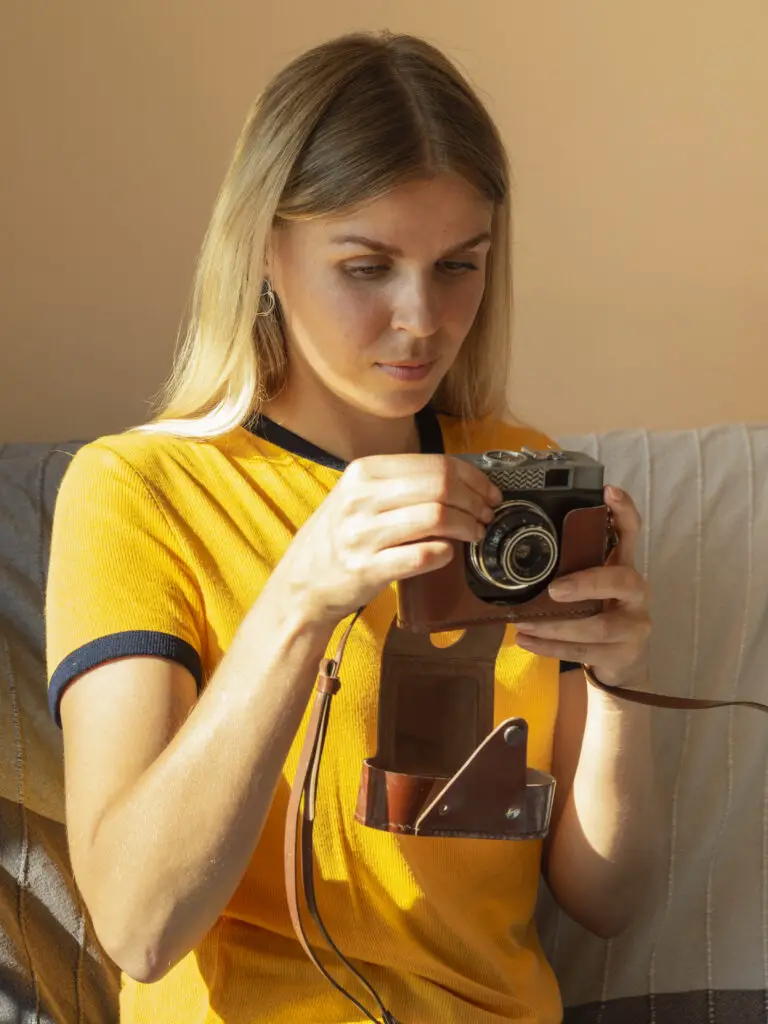
Thus, adjust the length so that the camera hangs at a convenient height for easy access and use. Ensuring the lanyard is the right length will make it more comfortable to carry and help balance the camera’s weight properly.
5. Test and Secure
Though, once the lanyard is attached and adjusted, test its security by gently tugging on it to ensure it’s firmly in place. Check all clips, loops, and adjustment mechanisms to confirm they are secure.
Make sure the lanyard doesn’t slip or come loose under pressure. Regularly checking the lanyard’s attachment will help maintain safety and prevent accidents or damage to your camera.
5 Methods to attach a lanyard to a camera
1. Using Built-in Loops
Thus, many cameras have built-in loops or rings designed for attaching lanyards or straps. To use this method, thread the lanyard’s hook or loop through the built-in ring or loop on the camera.
Make sure the lanyard is securely fastened and properly aligned with the attachment point. This method is straightforward and reliable, providing a secure connection without the need for additional equipment.
2. Attaching with Clips
If your camera has small attachment rings, you can use clips to connect the lanyard.
Open the clip and hook it onto the attachment ring on the camera. Ensure the clip is securely closed and check that it snaps into place properly. Clips offer a quick and easy way to attach and detach the lanyard, making them ideal for cameras that frequently need to be used.
Here, who makes gh pro camera bag?
3. Using a Strap Adapter
Moreoer, for cameras without built-in loops, a strap adapter can be used. Attach the adapter to the camera’s tripod mount or other secure points. Once the adapter is in place, connect the lanyard to the adapter’s attachment points.
This method provides a solution for cameras lacking dedicated lanyard loops and ensures a secure fit.
4. Threading Through a Case
Thus, some camera cases come with built-in loops or rings for lanyards. If you’re using a case, thread the lanyard through the loops or rings on the case rather than the camera itself.
Ensure the lanyard is securely fastened and that the case’s attachment points are strong enough to support the camera’s weight. This method is useful for added protection and easy access.
5. Using a Split Ring
A split ring can be used to create an attachment point if your camera lacks dedicated loops. Slide the split ring onto the camera’s existing attachment points or tripod mount.
Then, attach the lanyard to the split ring. Ensure the ring is securely in place and that the lanyard is firmly attached. This method is versatile and can be used to create a secure attachment point on various camera types.
5 Benefits to attach a lanyard to a camera
1. Enhanced Security
Attaching a lanyard to your camera provides added security, reducing the risk of accidental drops.
The lanyard allows you to keep the camera securely around your neck or shoulder, ensuring it’s always within reach and less likely to slip from your hands.
This is particularly beneficial when moving quickly or navigating crowded areas, as it provides an extra layer of protection against sudden movements that could otherwise result in dropping the camera.
2. Improved Accessibility
A lanyard makes your camera more accessible by keeping it readily available without having to fumble with bags or cases. It allows for quick, one-handed access, enabling you to capture spontaneous moments swiftly.
The lanyard also ensures the camera is always in the same spot, making it easier to grab and use at a moment’s notice, which is especially useful in dynamic shooting environments.
Here, why are camera bag so expensive?
3. Comfortable Carrying
Carrying a camera with a lanyard can be more comfortable compared to holding it in your hands or carrying it in a bag.
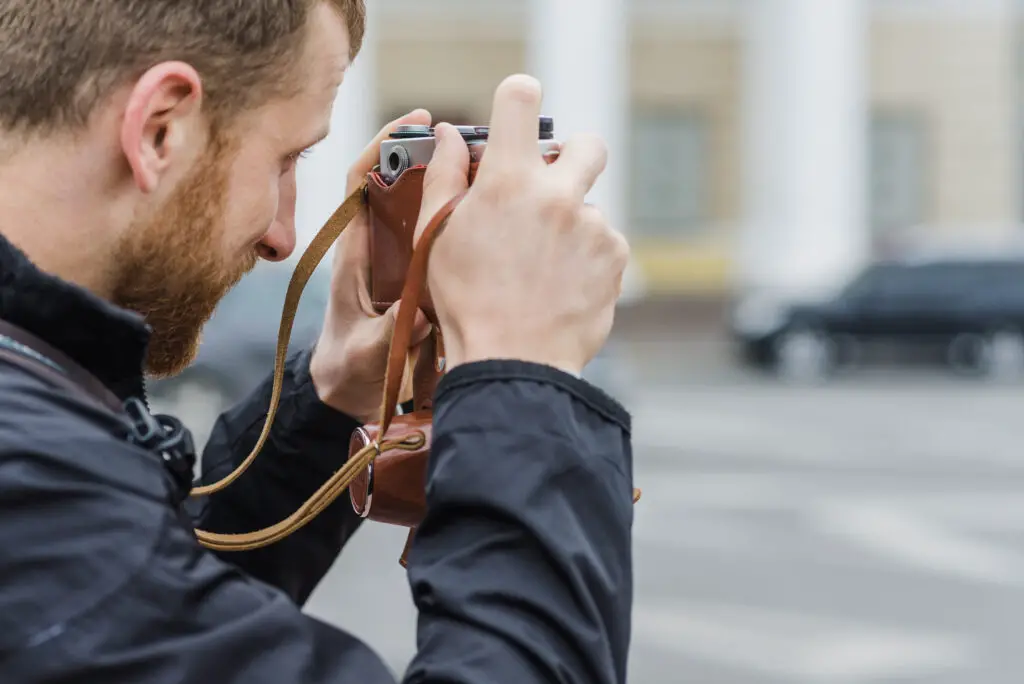
Well a well-designed lanyard distributes the camera’s weight across your neck or shoulder, reducing strain and fatigue during extended use.
Padded or adjustable lanyards enhance comfort further, making it easier to carry your camera for long periods without discomfort.
4. Prevents Misplacement
Thus, using a lanyard ensures your camera is always attached to you, reducing the chances of leaving it behind or misplacing it.
Whether you’re on a busy street or at a crowded event, having the camera secured to your body makes it less likely to be forgotten or left unattended. This benefit is particularly important for photographers who move between different locations frequently.
5. Versatile Use
Well, a lanyard offers versatile use, as it can be adjusted to suit different carrying preferences. It can be worn around the neck, across the shoulder, or even wrapped around the wrist for added security.
This adaptability allows you to use the lanyard in various shooting situations and environments, making it a practical accessory that can be customized to fit your needs and comfort level
Related faq’s
What type of lanyard is best for a camera?
Well, the best lanyard for a camera is one that is sturdy and adjustable. Look for lanyards made from durable materials like nylon or leather, with a strong attachment point.
How do I attach a lanyard to a camera with no dedicated loop?
If your camera doesn’t have a dedicated loop, you can use a camera strap adapter or threaded mounting point. Ensure the adapter is securely attached and can support the weight of your camera.
Can I use a lanyard with a camera strap that already has one?
Yes, you can use a lanyard in conjunction with an existing camera strap. You might need to attach the lanyard to a different point or use a quick-release mechanism to switch between the two.
What should I consider when choosing the length of the lanyard?
Choose a lanyard length that allows you to comfortably carry the camera while keeping it easily accessible. The length should enable you to hold the camera securely without it swinging around excessively.
How do I ensure the lanyard is securely attached to my camera?
However, make sure the lanyard is attached to a strong, secure point on the camera, such as the strap lugs or mounting threads. Double-check the connection to avoid accidental detachment.
Are there any safety concerns with using a lanyard on a camera?
Well, Yes, ensure the lanyard is strong enough to hold your camera’s weight and that it doesn’t interfere with any camera functions. A poorly attached lanyard could lead to drops or damage.
Can I use a lanyard with a camera case or cover?
Most camera cases or covers will not interfere with a lanyard if it’s attached properly. Just make sure the lanyard does not obstruct access to essential features or controls on the camera.
Conclusion
Attaching a lanyard to a camera is a practical way to enhance its portability and security.
Though, whether your camera has dedicated loops or requires an adapter, ensure you choose a sturdy and adjustable lanyard to match your needs.
Proper attachment is crucial; use strong connection points and double-check that the lanyard is secure to prevent accidental drops.
Well. by selecting the right length and material, and considering any additional equipment like camera cases, you can ensure that your camera remains both accessible and safe.
Thus, this simple addition can significantly improve your comfort and peace of mind while using your camera.

